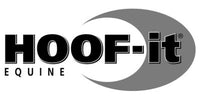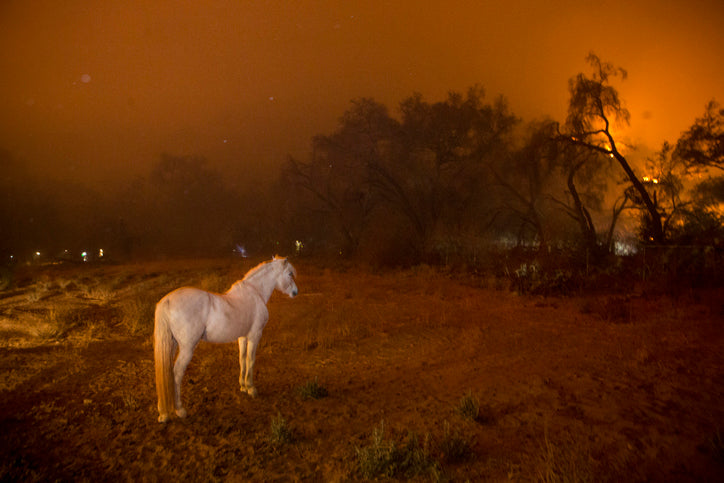Fire safety for your horses and barn
We've all seen the devastation that fires can cause and the terrifying images of barns and homes being consumed while people and animals alike run for their lives. We've seen the images of horses having to be turned loose by their owners in hopes that they can escape. Only to watch them run around in a panic, or worse yet, staying in their stalls where they feel they are the safest while the fire consumes everything around them.
Horses react to fear either by fleeing or by remaining stubbornly where they feel most safe.When smoke and fire prevent them from seeing an immediate escape, they may try to remain in a “safe” place—in this case, the stall.
In the blink of an eye, a fire can destroy a barn structure and all its occupants, while the owners stand by helplessly. Many advances in residential fire protection have been made, but protecting barns is much more difficult because of their harsh environment and housing requirements of the horses in them.
As ceiling temperatures continue to rise, the building acts as a boiler and the "flash point" is soon reached. When fire has reached the flash point, often in as little as 3 to 5 minutes, the hot air temperature simultaneously ignites all combustibles within the space. At flash point, survival within the structure is unlikely, and the building contents are destroyed.
Smoke is produced in the earliest stages of fire development. The color and density of the smoke is dependent on fuel and burning conditions. Low-temperature fires produce more visible smoke particles, creating darker, thicker smoke, whereas hotter fires have smaller particles in the smoke, making it less visible. Smoke and heat are the fire's killing attributes. Smoke contains noxious gases and vapors specific to the fuel. The most common products of combustion (fire) are carbon monoxide and carbon dioxide. As the fire consumes the available oxygen in the room, it releases carbon monoxide. When inhaled, carbon monoxide combines with blood hemoglobin more readily than oxygen would, resulting in suffocation, even if an adequate supply of oxygen is available.
Elevated levels of carbon monoxide and carbon dioxide increase respiration in an attempt to obtain more oxygen, resulting in the inhalation of more deadly gases. The consequences are swift through asphyxiation. Bodily harm from smoke is increased by its intense heat. When this super-heated mass of gases is inhaled, the respiratory tract will be seared. Smoke damage can occur even before flames are visible.
Once all available fuel sources have been used, the fire will "burn out." Unfortunately, this is not necessarily the end of the fire. Barns and agricultural buildings often contain large quantities of fuel sources that can be impervious to water (e.g., hay, petroleum fuels, and fertilizers). It is common for some of these fuel sources to remain un-burned during the initial fire, then continue to smolder. These smoldering pockets often ignite another fire.

Defensible Spaces
Wildfires start either directly (e.g., by lightning strike or an out-of-control campfire) or indirectly (e.g., embers). Windblown embers can travel a mile or more before landing on combustibles such as stored hay or shavings, leaves trapped in a gutter, or dried weeds piled up along a fenceline. The most important thing a horse owner or any property owner can do to reduce fire risk is create a defensible space around important structures. A defensible space is a landscaped area intended to reduce fire danger by minimizing vegetation and combustibles. If a wildfire sweeps in or sparks from nearby embers, having a defensible space reduces the risk that fire will spread to structures on your property. Defensible spaces also provide firefighters and emergency officials with access to safer defense points should a fire occur.
Design your defensible space by mentally drawing three concentric circles around important structures such as your home, barn, and outbuildings. The first circle should extend approximately 30 feet away from the structure’s perimeter, the second circle 60 feet, and the third 100 feet. The inner 30-foot circle is the most critical to manage. Plan for this area to have the highest water use, and keep these plants green throughout the fire season. Try to choose low-growing plants with high moisture content such as nonwoody deciduous shrubs or well-irrigated pasture/lawn. Talk to your local extension office or conservation district staff for help with choosing landscaping plants and materials that are well-suited for your region and not considered highly flammable.
Between 30 and 60 feet out from buildings you can add slightly taller drought-tolerant shrubs and plants. Plants with high salt or soap content and low oil or resin content are the least flammable. From 60 to 100 feet out from buildings, you can include trees. Deciduous trees are generally more fire-resistant than evergreens because they have a higher moisture content when in leaf, and they have a lower fuel volume when dormant. Avoid junipers and pines, both of which are highly flammable. In the outer two zones remove deadwood and trim vegetation in the spring to reduce size. Incorporate rock mulches, patios, boulders, riprap, dry streambeds, and sculptural inorganic elements into your landscaping plan as fuel breaks, as well as masonry and rock planters. Driveways, walkways, patios, parking areas, and fences constructed of nonflammable materials such as rock, brick, or cement also reduce fuel loads, as do water features, pools, ponds, or streams. Be creative, keeping in mind that less is more.
Firewise Building
When planning for new outbuildings, place them as far apart as is reasonably possible—at least 30 feet is best—to create a fuel break between them.
When feasible, build barns, shelters, and other structures on flat land rather than hilltops or in draws (low areas between parallel ridges). During a fire these areas act as chimneys, pulling hot air and flames rapidly up hillsides. Once at the top, these intense flames will consume anything combustible.
Choose nonflammable building materials such as metal sidings and roofs for barns and shelters. Avoid building log or wood structures—building codes in some areas won’t even allow such structures because of fire risks.
The most fire safe fencing is wire or panel with nonflammable posts. A wood fence line can act like a wick, leading a fire right up to a barn or shed. If you already have this type of fencing in place, you can install a gate or removable panel that you can leave open or take out during fire threats. Be aware that plastic fencing will melt and is not a good fire wise choice.

Reducing Fuel Loads
In the spring or before fire season begins, inspect your property for potential flammables. One of simplest things you can do is clean gutters and downspouts; remove leaves, branches, and other debris where embers could possibly land and ignite. Clear weeds or dead brush accumulations from along fence lines and around building corners and walls.
During fire season water vegetation within 100 feet of buildings and keep them mowed low or grazed down. Use grazing goats or other livestock to reduce cheat grass or other weeds in fields or behind barns. You can also remove weeds in these larger areas with mowing, prescribed burning, or herbicide application.
Remove as many flammable outdoor items on your property as possible; examples include anything that might catch an ember and ignite, such as wood patio furniture, brooms, flower boxes, or flammable doormats. Replace them with nonflammable materials such as wrought-iron patio furniture and the cement or stone planters described. Store hay, shavings, firewood, trash, lumber, and empty feed sacks at least 30 feet away from buildings and other combustibles.
If a wildfire does break out in your area, decide early on if you need to leave. Late evacuation is a deadly option, risking human and animal lives. If you are unprepared or wait until the last minute to evacuate, emergency officials might tell you to leave your horses behind. Once you leave your property there is usually no way of knowing how long you will be kept out of the area, and horses left behind could be unattended for days. “If landowners are going to stay and try to evacuate their livestock,” Johnson adds, “that’s going create a whole new dimension to the evacuation process.” If you choose to stay and actively defend your property from fire, you need to be well aware of risks.
Everyone’s situation differs according to the size and nature of their horse enterprise, which is why she says every horse owner needs to develop an individual evacuation plan before hot weather and fire season arrive. Use this list to help you organize your own fire wise evacuation plan.

THINGS TO REMEMBER
In an emergency defer to local authorities The county sheriff is always in charge of evacuations. If possible, listen to local radio stations or contact 911 for instructions.
Decide in advance which horses you will evacuate and make sure they are trained for transport. If you do not have enough trailer space for all of your horses, determine ahead of time if someone will be available to help haul in an emergency.
During a fire situation remove all synthetic equipment from horses, such as nylon halters, blankets, sheets, and fly masks. People often mistakenly think these materials will protect horses from windblown sparks when, in fact, if an ember alights on them, it can melt and burn the horse. Instead, use cotton or leather halters and leads and avoid leaving metal- and buckle-laden equipment on them, which can get extremely hot.
Pre-determine possible locations to take your horses in the event of a fire. Options include another horse property, a regional stockyard or livestock sales yard, county fairgrounds, show facilities, a racetrack, or even a large park.
When evacuation is not possible, place horses in the firesafe area on your property that you have created ahead of time. It should be as large as possible, devoid of flammable vegetation, and surrounded by fireproof (metal) fencing. A firesafe area could be a large sand arena, a large drylot turnout, or an overgrazed field or pasture. If time permits, put nonflammable metal containers full of feed and water in the middle.
If you have to leave horses behind, consider identifying them by writing your cell phone number on their front hooves with an indelible marker or on their hips with a grease marker (the type used for cattle sales or endurance rides).
Finally, never, ever turn horses loose This is the No. 1 rule, but it’s one that horse owners break frequently. In situation after situation, officials have had to deal with loose horses on roadways blocking both traffic and emergency personnel who are trying to deal with the fire. Loose horses become an additional liability, especially if they cause an accident or get injured and exacerbate a crisis.
Following some simple rules and having a plan in place before there is an emergency can save you and your animals in the event of a fire.

